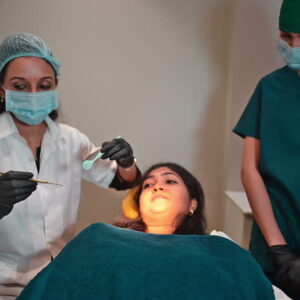The perfect harmony between the denture and the jaw is necessary for a dental prosthesis. The complete denture includes maxillary and mandibular teeth that should be perfectly oriented. Various dental lab equipment is used for the construction of dentures. Experienced dental technicians and efficient instrumentation are necessary for dental construction. A dental facebow is a similar device used in the dental lab for the fabrication of partial and complete dentures. Let’s go over the basics of dental facebow.
What is a dental facebow?
A dental facebow is an instrument used to determine the correct relationship between the maxillary and mandibular arches in dental prostheses using anatomical references such as condyles. The impression is a negative representation of the teeth. The impression is poured with a special dental material, and molds are fabricated for further processing. Face bow help in the mounting of molds on the articulator. The Dental Facebow records the spatial relationship of both arches with the condyle or TMJ. The correct relation can aid in various jaw movements like chewing, mouth opening, speech, and protrusive movements of the jaw. Dental Laboratorio has the best quality dental face bow for the recording of jaw relationship and denture orientation.
The dental facebow has a dense structure that can customize the jaw relationship and help build the aesthetic component of the prosthesis. Every individual has a unique set of teeth. The construction of a custom denture requires replication of all the components in the restoration.

Parts of the dental Facebow:
The facebow is composed of various parts depending on their type. The Artex Dental Facebow is the most widely used piece of equipment. It has the following components.
- U-shaped frame.
- Condylar rods.
- Bite fork.
- A locking device
- Orbital pointer.

The U-shaped frame is the extraoral component that offers the attachment of all other parts. The biting fork is embedded in the wax pattern for intraoral placement and biting. The condylar rod provides the reference point for the jaw joint and replicates the condyle of the TMJ.
Facebow can be classified into various types with slight differences in use, components, and method. The two main types are;
- Kinematic Face-bow
The kinematic type orients the actual terminal hinge axis. The hinge axis is established, and the dental facebow is oriented around the hinge axis. It aids in denture fabrication around the centric relationship of the dental arch.
2. Arbitrary Face-bow
It can be with and without condylar rods. The most commonly used type is the arbitrary facebow, which does not require a hinge axis for orientation. It is classified as follows:
- Facia Type
- Ear Piece Type
- Hanau face-to-face
- Slide Matic
- Twirl bow
- Whip mix
Applications of the Dental Facebow:
The upper and lower jaws have a unique relationship regarding the skull. The Artex Dental facebow assists to maintain the relationship and the jaw. The jaw can be horizontal, transverse, vertically oriented. It aids in bite fixation and transfers to the articulator.
Occlusion stability is important for the denture. Any defect in tooth positioning or arrangement leads to prosthesis failure and serious oral consequences. The facebow brings the teeth into occlusion with the bite record of patients and offers a flawless tooth arrangement.
- Maintain the aesthetic component.
Dentures and dental prostheses not only assist in mastication and speech but also improve patients’ appearance. The vertical height and horizontal dimension enhance the appearance and give the ability to smile confidently.
- Artex Dental Facebow Transfer:
Modeling wax can be used for bite registration. The wax is encased in a bite fork, and the patient is instructed to bite it. After establishing the proper relationship, the bite fork is removed and attached to the articulator.
Dental Laboratorio carries a large collection of top Dental Facebows that are Artex dental system compatible. You can select suitable equipment for your dental practice by visiting our site.





